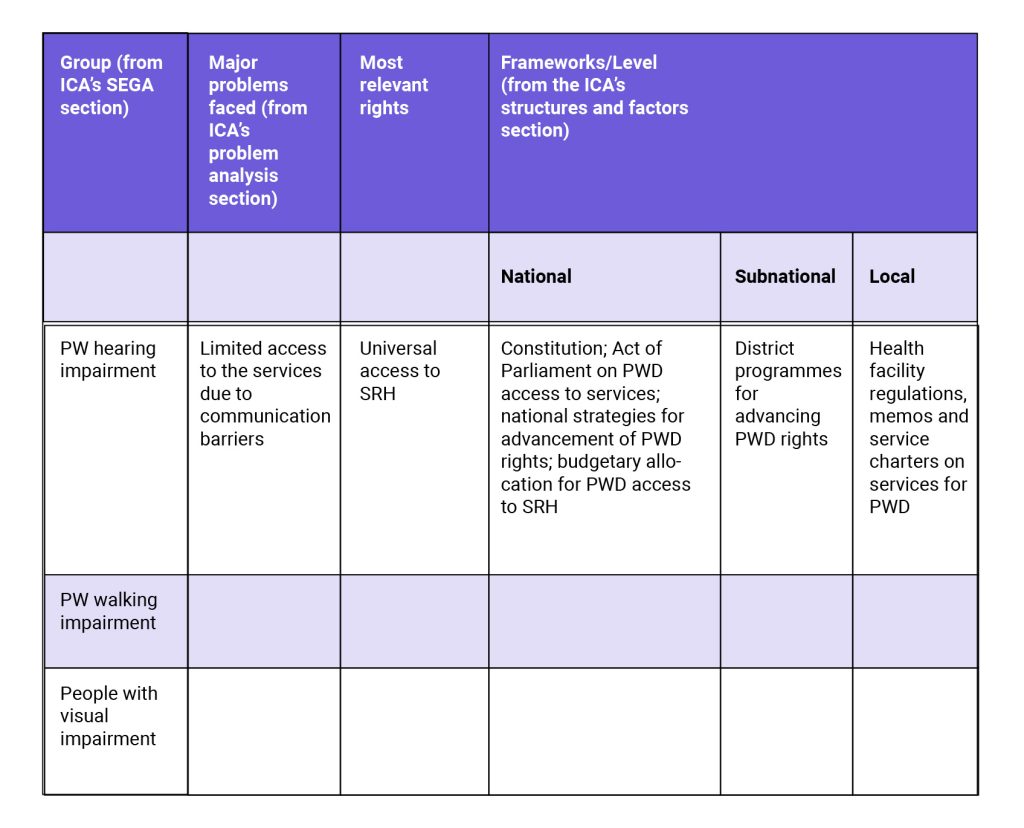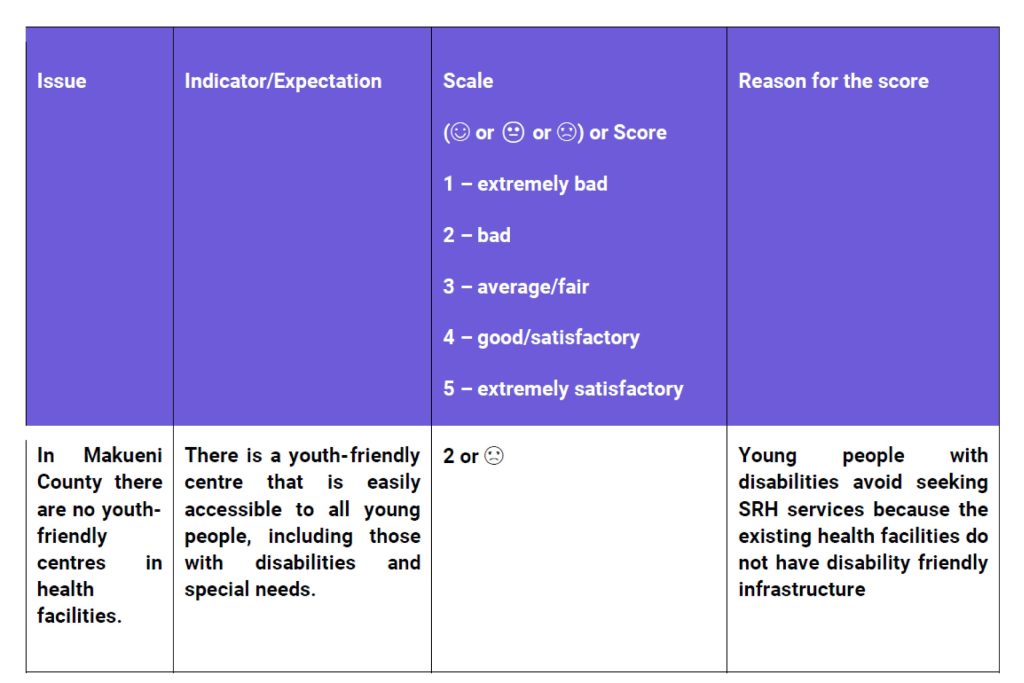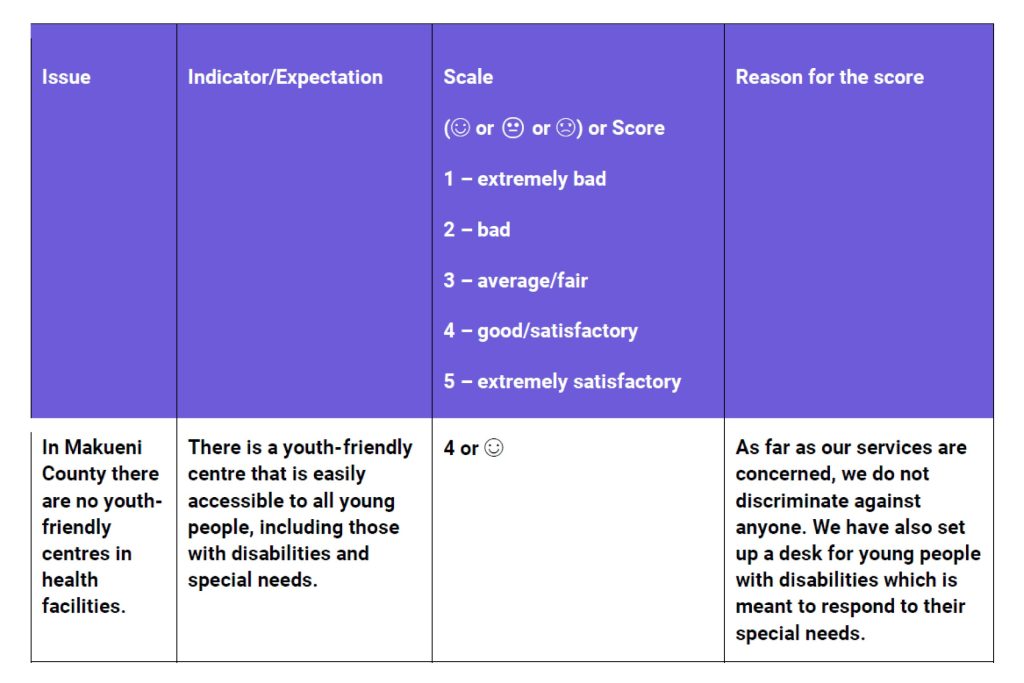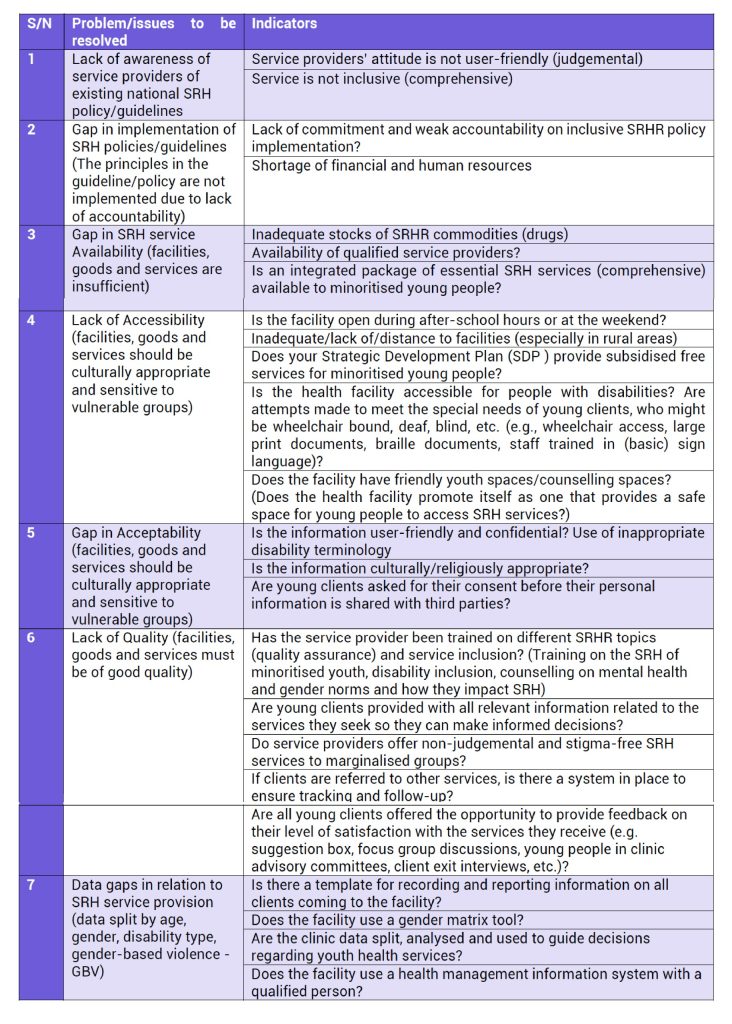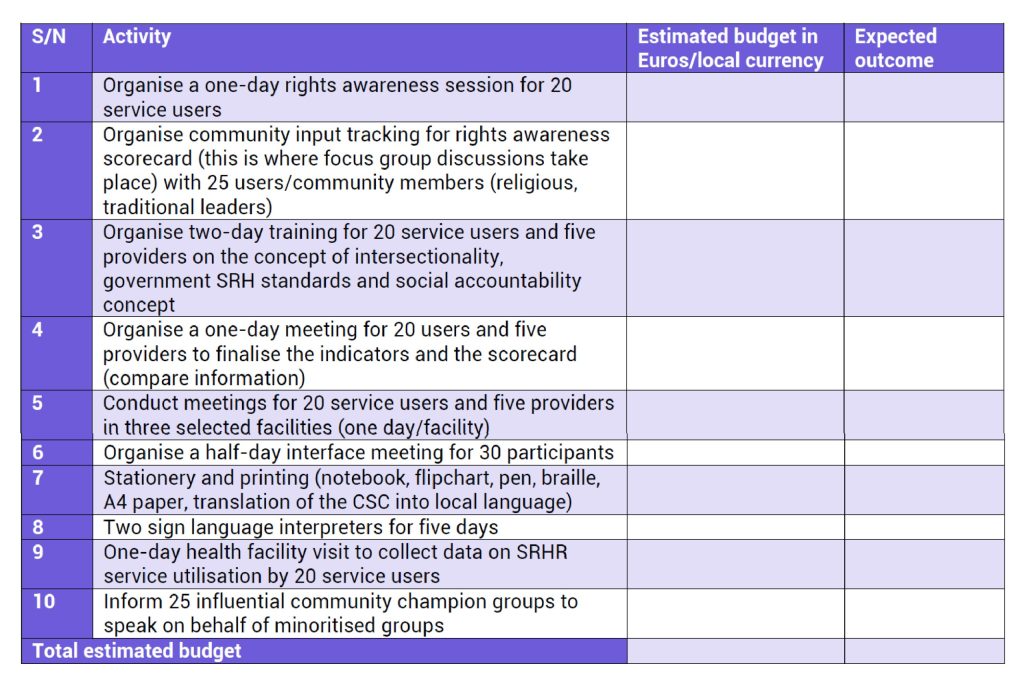
Tool
The Intersectional Community Scorecard
Practical guide for facilitators
Table of content
Background
Step 1: Understanding and preparing for the context
Step 2: Build rights awareness
Step 3: Evaluation by minoritised youth
Step 4: Duty bearer self-evaluation
Step 5: The interface meeting
Step 6: Action and follow-up
Additional material
Watch the introduction video of the Intersectional Community Scorecard:
Background
The main aim of this tool is to help youth with compounded vulnerabilities use the Intersectional Community Scorecard (ICSC) process to promote and claim their sexual and reproductive health and rights (SRHR). The tool targets three main outcomes. First, the objectives of ICSC processes must explicitly address the sexual and reproductive health and rights (SRHR) needs and priorities of minoritised youth, while improving the Availability, Accessibility, Acceptability and Quality (AAAQ) of SRH services. Second, minoritised youth must be the main target group of all ICSC processes. The third objective is to engage minoritised youth and facilitate their active participation in implementing most of the ICSC activities from this tool.
The Community Score Card (CSC) is one of the social accountability tools designed to deliver tangible results by encouraging interaction between service users and service providers to improve SRHR Service delivery. The Make Way programme seeks to utilize the intersectionalised CSC to promote the engagement between vulnerable youth/YWCV and duty bearers and other power holders to improve the acceptability, accessibility, affordability, and quality of SRH services. The programme puts special emphasis on the intersectionalisation of the CSC in order to ensure three main outcomes in favor of vulnerable youth/YWCV. First, the intersectionalised approach requires that vulnerable youth/YWCV are at the center of the ICSC process in shaping its design, objectives, activities, and outcomes. Secondly, the approach requires that the core activities of the ICSC process are undertaken with the meaningful and consistent participation of the vulnerable youth/YWCV. Thirdly, the SRH needs of the vulnerable youth/YWCV, including improvements in the Availability, Accessibility, Acceptability and Quality (AAAQ) of SRH services, will constitute the main expected outcomes of the CSC process.
Implementing the scorecard involves six steps:

Step 1: Understanding and preparing for the context
Before conducting an ICSC process (see details on page 15 of the main Intersectional Community Scorecard guide), you need to carefully plan and prepare. The five exercises will give you a greater understanding of the context. We would advise you to use all the exercises if this process is new to you.
Exercise 1: Problem/solution tree
This exercise generates the key areas of focus that the ICSC approach should target.
Creating the problem tree:
- Before setting out to roll out the ICSC process you need to do a country/operational setting context analysis that examines at least how young people are affected by socio-cultural exclusion and gender (in)equality as well as the historical, political and economic situation.[1]
- Refer to the problems identified in your context analysis.
- Pick out the most relevant problems for the ICSC, based on the target group, facility and capacity, to tackle the problem.
- Note down why the problems you selected are important and what caused the problems in the first place.
- Identify and note down examples and illustrations that show how the problems are noticeable (e.g., minoritised young people avoid going to their local public health facility because it doesn’t have a youth-friendly centre).
- Identify and note down all possible effects of the problem on minoritised young people (e.g., contraceptives and SRHR information are not available and so there are many teenage pregnancies among this group).
- Use the problem tree to distinguish
- the main causes of the problem (the roots: e.g., the government is not investing anything or enough in SRH services for youth)
- … from how it becomes apparent (the trunk: e.g., lack of a youth-friendly centre at a health facility)
- … and its immediate effects (the branch: e.g., lack of contraceptives and SRHR information for all youth)
- … and its end results (the fruit: e.g., increased teenage pregnancies among minoritised young people).
- Ensure that the causes, trunk, branch and fruit are as clearly stated as possible.
- Turn the problem tree into a solution tree:
- the root causes become the main solutions (e.g., increased government investment in SRH services for all youth)
- the trunk becomes the main intervention needed to solve the problem (e.g., establish youth-friendly centres that provide contraception and SRHR information for all youth in health facilities)
- and the fruit is the main outcome of the solution (e.g. reduced teenage pregnancies among minoritised young people).
- Use the ‘trunk’ (establish youth-friendly centres in health facilities that provide contraception and SRHR information for all youth) as the main objective of the ICSC approach – the basis for the rest of the analysis and planning.
Example of a Make Way problem tree
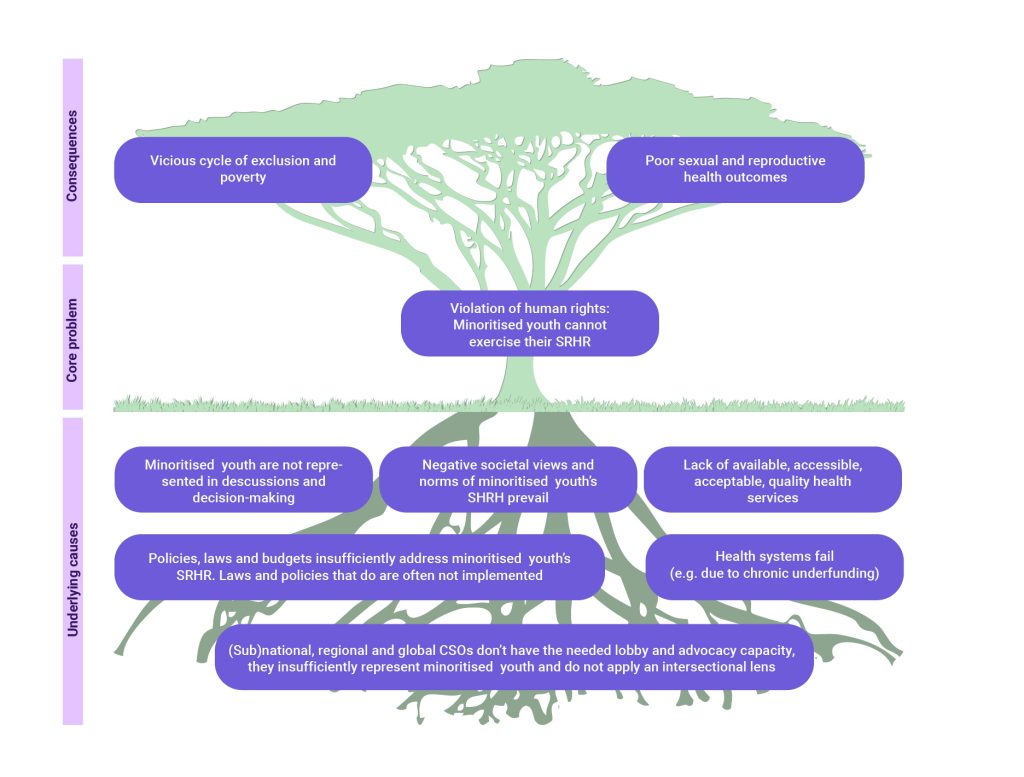
Note: When you do your analysis of root causes you should pay attention to how the roots grow out of the structural or systemic social, cultural, political and economic factors you identified in your context analysis; e.g., there is low spending on SRH services because investment in the health sector is weak due to a national economic model based in extracting natural resources, a state of affairs inherited from colonialism. This more holistic understanding of the root causes can help you develop actions that produce deeper, more sustainable change. And when you decide to use the ICSC findings for advocacy it will help you to be strategic in building alliances or act in solidarity with organisations working on broader issues, e.g., fighting for a fair, ecologically sound economic model that serves all citizens equally.
Exercise 2: Stakeholder power analysis
This exercise helps you identify key stakeholders you need to engage and convince and others who should be part of the ICSC problem-solving approach. It also helps you understand who you need to manage or control to mitigate risks to achieving your objective.
To do:
- Map out everyone with an interest and influence on the issue identified as the main objective of the ICSC process (by using your county/setting context analysis).
- Describe the interest each identified stakeholder has in the objective, rating this as high, medium or low.
- Describe the power/influence each identified stakeholder exercises over the objective and rate this high, medium or low.
- Plot the stakeholders on a template that indicates both their interest and influence on the objective.
A point to remember when doing a stakeholder analysis: everyone concerned should be defined as clearly as possible, to establish exactly who they are. This particularly applies to big entities such as government, where you need to refer to each specific government agency involved.
Example of a stakeholder power analysis
Note, this is the simplest matrix for a stakeholder power analysis. There are several different types that categorise stakeholders differently, e.g., some include “bystanders” and “abstainers”, as well as include more categories. 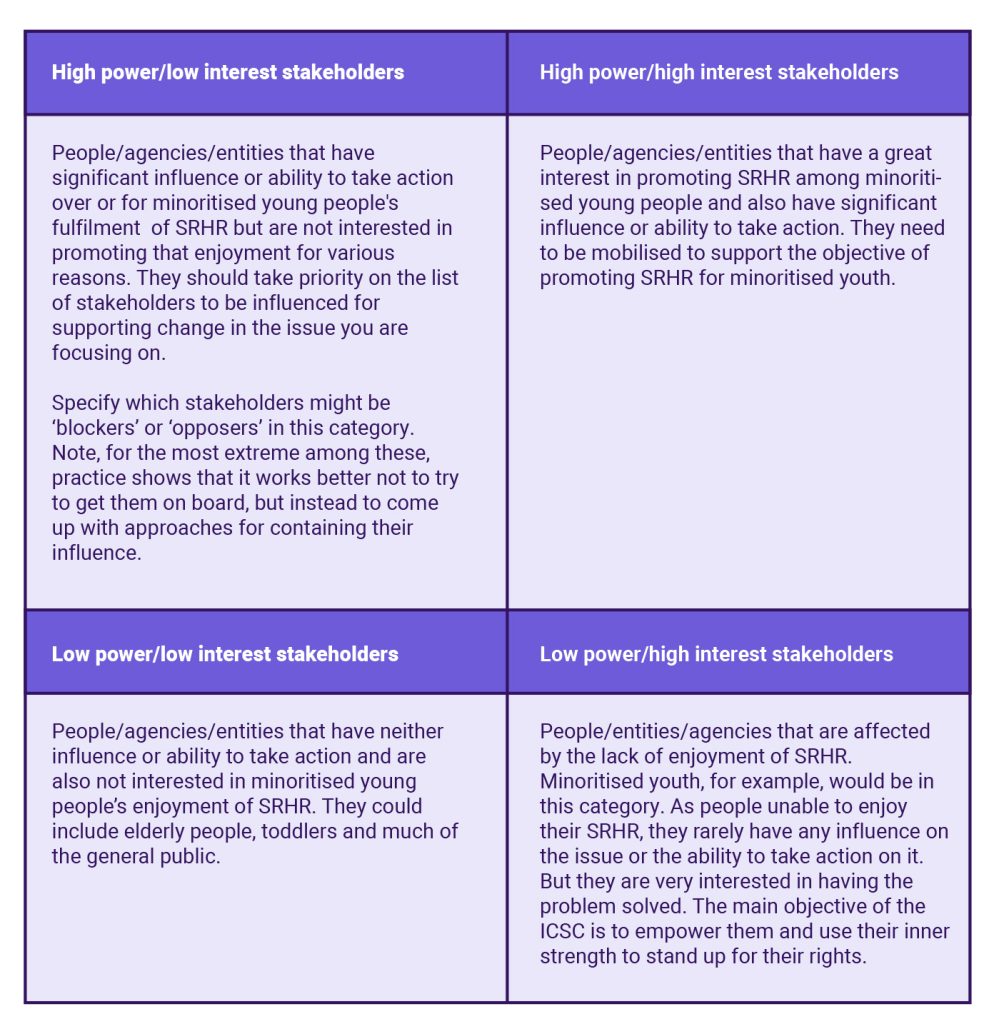
As you do this exercise reflect upon and make a note of how different stakeholders can have different effects on the SRHR and access to SRH services of different groups of young people with multiple, overlapping identities. For example, due to their ideas of morality, some religious leaders vocal in the community or active on a community health board may be influential in preventing young sex workers, young drugs users or young gay men from seeking or obtaining fertility and family planning services. They may not have such an effect on young people born with HIV, whom they might view as ‘innocent’. Reflect on and register if and how the level of influence changes if these young people have additional identities assigned to them, such as being transgendered or having a disability. Also, take into account the power dynamics between influential stakeholders. For example, a health facility ‘in-charge’ may do the bidding of an older community leader even though the in-charge is the decision-maker on the health facility work floor. How does that kind of shift in power affect if and how young people will access SRH services?
Exercise 3: Safety and security analysis
You should identify the harms and risks that could result from applying the ICSC approach. Everything possible should be done to ensure the safety of vulnerable or marginalised young people and to prevent re-traumatising them.
To do:
- Establish whether there are any potential risks that could expose your ICSC participants, by asking questions like: 1. Does the problem tree indicate solutions which would expose ICSC participants to harm from people or organisations opposed to the SRH rights of minoritized youth? 2. Does the stakeholder analysis bring on board stakeholders that could potentially cause more harm than good, and who should be handled carefully? 3. Are there entrenched cultural and religious practices that would make the approach unacceptable in certain communities? 4. Is there a legal risk for the participants? 5. Is there a risk to maintaining the anonymity or privacy of participants?
- Make a list of all the risks that have been identified.
- Make a list of measures that are needed to reduce the risks you have listed. Link appropriate action(s) to each risk.
- Once both the risks and the activities to reduce them have been finalised, the document should be used as the ICSC’s Safety and Security framework. It should guide all ICSC activities in subsequent steps of the ICSC process.
- Working with vulnerable people means making sure you can support them if need be. Prepare to be able to refer a participant in need to agencies or organisations that can provide medical, legal, and/or psycho-social support. Do this only if they consent to it.
Exercise 4: Mobilisation of key stakeholders
This exercise helps you to mobilise stakeholders, make them more aware of the importance of an intersectional CSC approach, and get them to agree to participate in the process.
To do:
- Identify key youth gatekeepers in groups of minoritised youth who would be important when you are mobilising these young people to participate in the ICSC process.
- Visit targeted groups of minoritised youth together with the gatekeepers to invite them to take part in the process.
- Introduce the ICSC approach to the target groups, responding to any questions they have.
- Ask the groups for their commitment to be part of the approach.
- Agree on dates and venues for meetings to start Step 2 in the ICSC process.
- Clarify expectations and outcomes from the process.
- Identify key officials and leaders among the duty bearers responsible for SRH service provision who would be critical in mobilising other duty bearers for the process.
- Visit the targeted duty bearers and introduce them to the process.
- Get the duty bearers to agree to the process.
- Agree on dates and venues for Step 3 of the ICSC process.
- Clarify expected outcomes and manage the duty bearers’ expectations.
Step 2: Building rights awareness
Step 2 aims to build the capacity of vulnerable youth/YWCV on their rights and entitlements. Having been mobilised earlier for the iCSC process, this step works with those vulnerable youth/YWCV who have been identified to steer the intersectional CSC process as community facilitators. The step is therefore marked by capacity building activities, in which participants are not just made aware of the rights and entitlements of the target communities, in this case, vulnerable youth/YWCV, but also the whole iCSC process. They are then expected to use this information to implement the subsequent steps of the iCSC as its facilitators. Training themes include:
- Information on government obligations gathered through the Rights Analysis matrix (see Table 2 below. You can also refer to Annex 8).
- Rights and Entitlements of citizens, in this case, vulnerable youth/YWCV including the right to AAAQ SRH services as well as the right to participate in governance decisions involving SRH services.
- The importance of the iCSC process and how it can be used to facilitate vulnerable youth/YWCV to demand for their right to AAAQ SRH services.
- How to undertake an iCSC in order to support vulnerable youth/YWCV to enjoy their SRHR
Table 2: Rights Analysis Table
Tips on Rights Awareness from the iCSC Field Testing
- Divide tasks among facilitators to increase efficiency and effectiveness in delivering on this step.
- Tailor the training to the literacy levels of the participants
- Use language that is accessible to them.
Training themes to share information about, include:
- Information on government obligations gathered through the input tracking process, including their commitments and the standards of SRH services.
- Rights and entitlements of citizens – in this case, minoritised youth – including the right to the availability, accessibility, acceptability and quality of SRH services, as well as the right to participate in governance decisions involving these services.
- The importance of the ICSC process and how it can be used to facilitate minoritised young people to demand their right to AAAQ SRH services.
- How to undertake an ICSC in order to support minoritised youth to enjoy their SRHR.
Step 3: Evaluation by minoritized youth
Step 3 should start with a visit to the groups of minoritised young people. If you use gatekeepers ( e.g., community leaders, chiefs etc) with networks among the targeted communities as the key entry point, the evaluation process is usually successful.
You may not immediately be able to engage the most vulnerable or marginalised, and the young people you meet are likely to point you to other young people who share their characteristics. So, you should keep probing to identify young people who have other types of identities and are not visible or connected to youth groups, for example. As part of this step, ask yourself who has gotten the opportunity to participate and who might have been left out of this process? Can gaps or oversights be corrected?
Generating issues
To do:
- Meet with the identified group of minoritised young people at a specified venue.
- Agree on rules for the meeting and key meeting outcomes.
- Ask the whole group of minoritised youth in a plenary session to identify broad issues related to the main objective identified in Step 1 of the ICSC (e.g., construction of a youth-friendly centre in a health facility).
- Divide the young people into several focus groups for more in-depth discussions on the issues identified. The groups could be divided based on dynamics such as age, where they come from, gender, etc.
- Set up separate discussion groups that take place alongside the plenary discussions. This is to ensure a safe space for young people who are further minoritised within the group, giving them an opportunity to speak during the issue-generating discussions. It could include young people with disabilities.
- To be inclusive with young people with disabilities, make sure the location where you meet is accessible and measures are taken to accommodate the needs of sight-impaired and/or death youth.
- Each focus group should identify the most important issues it feels should be addressed by the ICSC process.
- Ask all the groups to present their chosen issue(s) in plenary.
Scoring on the issues
To do:
Introduce a matrix for guiding the discussion around scoring on the main issues.
Example of a community evaluation matrix
Choice of representatives and finalising step 3
To do:
- Tell the young people who are participating about the next steps.
- Ask them to choose people to represent them during meetings (usually from those in their group who were the most vocal and visible or who had clear examples of the issues identified). Be mindful of power dynamics among the young people themselves. Be explicit about the importance of making sure everyone can claim space and voice and try to correct for imbalances. Be strategic in order not to offend or create negative feelings among the participants.
- Photocopy the community evaluation score sheet and give a copy to the representatives.
- Inform the representatives about the venue, date and expected outcomes of the interface meeting.
Check in with the young people participating in this process on how they are experiencing it. Do they all feel equally included? Do they feel safe? Address gaps and challenges to meaningful participation for all involved.
Step 4: Duty bearer self-evaluation
Duty bearers are usually public officials or people working at formal institutions, so generating and validating issues among them is a slightly different process.
Generating issues
To do:
- Meet with the identified target group of duty bearers at a venue such as their place of work.
- Agree on rules for the meeting and key meeting outputs.
- Present the issues generated in the community meeting under Step 3. At this time, only present specific issues that the minoritised young people identified as the most important in their relationship with duty bearers.
- Ask the duty bearers to respond to the issues using a duty bearer self-evaluation matrix. This will limit them to using the two columns for giving their own scores, and reasons for the scores, on the score sheet already generated by the minoritised young people.
Scoring on the issues
To do:
Ask the duty bearers to give their own scores based on how they perceive the issues, and their reasons for this.
Example of a duty bearer self-evaluation matrix
Choice of representatives and finalising step 4
To do:
- Tell the duty bearers about the next steps.
- Ask them to choose people to represent them and voice their issues during meetings. Be mindful of power dynamics among duty-bearers as well. Try to address imbalances in a strategic way, as above with the young people.
- Invite them to the interface meeting and ask for their help in generating a joint action plan that would address issues of concern to both duty bearers and the minoritised young people.
- Photocopy the self-evaluation score sheet, and give a copy to the representatives.
- Inform the representatives and the duty bearers about the venue, date and expected outcomes of the interface meeting.
Step 5: The interface meeting
During this phase, the duty bearers and the minoritised young people are brought together to discuss the issues they generated and the scores they gave, plus the reasons for the scores. It is during this discussion that the two sides should develop and agree on a collective response to the challenges.
Preparing for the interface meeting
To do:
- Visit the site of the event prior to the meeting, to ensure accessibility, suitability and the availability of a wall or other vertical space to display the score sheets.
- Identify the people who need to be invited (see text box below).
- Transfer the score sheets into large print that will be visible to all those attending the meeting.
- Have a third blank sheet between the two sets of scoresheets on which you can write emerging solutions that could form part of the action plan.
- Divide roles and responsibilities with another facilitator (lead and assistant). The lead facilitator leads the discussions, directing the pace and seeking clarity in cases of non-clarity. The assistant largely provides support by noting down the emerging issues.
- Draft an agenda outline (see text box below).
Suggestions for an interface agenda
- Prayer (depending on the context).
- Introduce the community facilitating team and explain their role for the day.
- Review the purpose of the meeting and expected outcomes.
- Go through the SRH Code of Conduct.
- Discuss the issues from the focus groups.
- Draw up an action plan divided into the short, medium and long term.
- Discuss with the participants who will benefit from the intended changes and who may not.
- Review the specific, planned corrective actions to make sure that they would not have an unforeseen negative impact, for example, on a group of marginalised youth that was not or could not participate in the ICSC process.
The following people should attend an ICSC interface meeting, but others could also be included:
- Minoritised young people who were involved in the community scorecard assessment of SRH services.
- Service providers from the health facility that was assessed.
- Local leaders – e.g., subcounty leaders responsible for overseeing the delivery of SRH services at the health facility.
- Relevant community leaders such as heads of local religious and cultural institutions.
- Local politicians (if possible) or elected leaders from within the area the health facility serves.
- Local NGOs and community-based organisations (CBOs) involved in the service.
During the interface meeting
To do:
- Have participants sit on separate sides of the room, with the facilitators sitting in what represents the middle – as mediators in the discussion.
- Ask the youth representative to present their score sheet. They should be given the opportunity to present all their issues, scores and reasons without any interruptions from the duty bearer side (let the duty bearers know that they will be able to respond afterwards). Encourage the youth representative to provide as many clear examples as possible, with the help of other young people present at the meeting where necessary.
- Invite duty bearer representatives to present their own score sheets. This will include a direct response to the issues raised.
- Allow for an exchange of perspectives. Be professional and avoid taking sides during the discussions. Offer both sides an equal opportunity to present their cases. At the same time, make sure that the minoritised young people are given all the time they need to speak, and that the meeting is not dominated by the duty bearers, who are likely to be more forceful than the young people.
Step 6: Action and follow-up
Identifying the key action
To do:
- Draw the participants into a discussion aimed at resolving the issues generated (the assistant facilitator should unveil a large print of an action plan – see annex for the sample that’s clearly displayed on the vertical wall space). The solutions suggested should be within the scope of the participants.
- Ask the participants to choose representatives for a Joint Monitoring Committee (JMC) that would be responsible for implementing the action plan. Have at least two members from each side, with the facilitator offering to be a non-executive member.
- Get the committee to agree on its working calendar, including a schedule of activities and meetings. Conducting ‘repeat scorecard’ activities in 6-9 month intervals is seen as good practice.
Linking the action plan to the lobbying and advocacy strategy
Several key actions identified during the action planning require the attention of stakeholders and others beyond the immediate sphere of the facility. These require a response through policy change and institutional reform, both of which would necessitate engagement with authorities at a higher level than facility-level duty bearers.
To do:
- Formulate indicators with the various problems/issues identified.
- Formulate an action plan with timeline, person(s) responsible, resources needed.
- Formulate a budget with all identified activities in your action plan.
- Work with policy advocacy officers from the Make Way programme to package these problems into a detailed lobbying and advocacy strategy. They should then draw the attention of appropriate duty bearers to the entrenched problems emerging from the action plan.
Examples of identified issues with indicators
Example of a joint action plan generated during an interface meeting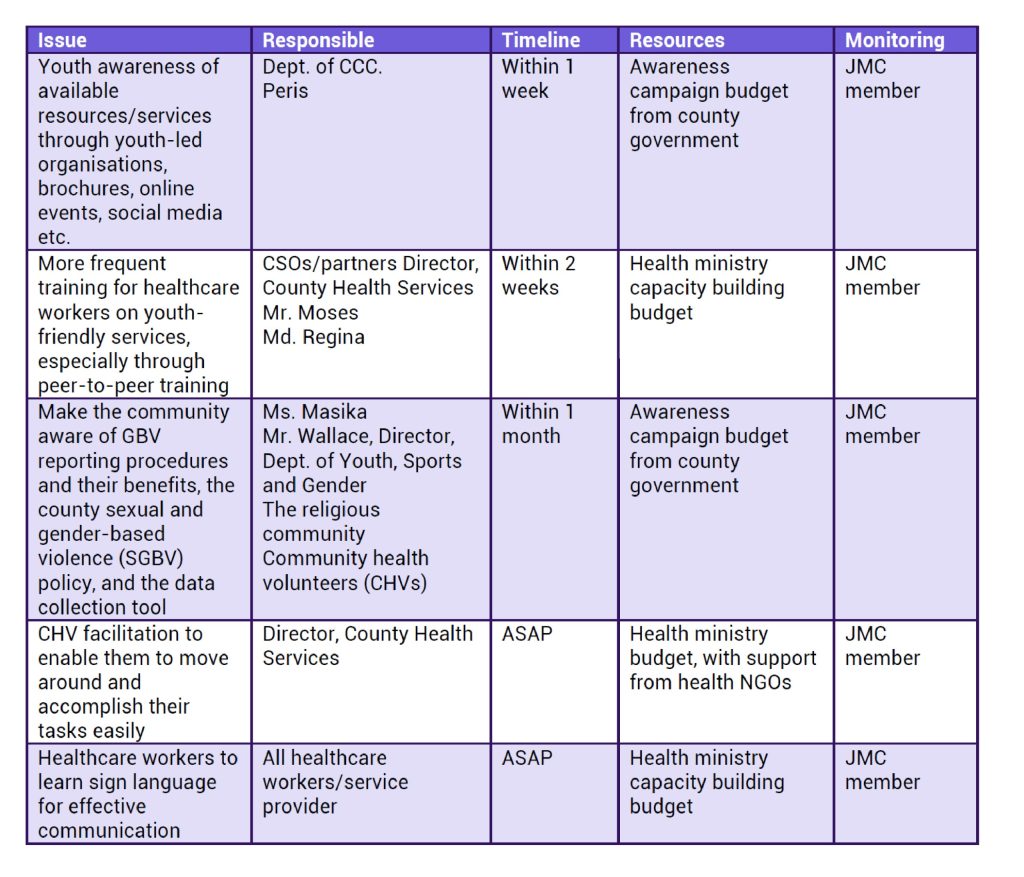
Example of a budget structure for the Community Scorecard process
Additional material
[1] VSO’s Community Score Card, on which this tool is based, uses VSO’s Social Exclusion and Gender Analysis (SEGA) and Political Economy Analysis (PEA) approaches.
Your questions and suggestions:
"*" indicates required fields


